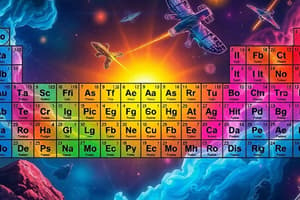Podcast
Questions and Answers
What was the main observation made by John Newlands regarding element properties?
What was the main observation made by John Newlands regarding element properties?
Newlands observed that the properties of the eighth element in a sequence resembled those of the first element.
How did Newlands compare the arrangement of elements to music?
How did Newlands compare the arrangement of elements to music?
Newlands compared the arrangement of elements to octaves in musical notes, where every eighth note resembles the first.
What limitation did Newlands face with his Law of Octaves?
What limitation did Newlands face with his Law of Octaves?
The Law of Octaves only worked well for lighter elements up to calcium and failed for heavier elements.
What are the triads and who identified them?
What are the triads and who identified them?
Give an example of a triad identified by Dobereiner.
Give an example of a triad identified by Dobereiner.
Why was Dobereiner's system of classification not successful?
Why was Dobereiner's system of classification not successful?
What relationship did the atomic masses of strontium, calcium, and barium have?
What relationship did the atomic masses of strontium, calcium, and barium have?
How many elements were known at the time of Newlands' proposal?
How many elements were known at the time of Newlands' proposal?
What was the significance of the elements chlorine, bromine, and iodine in Newlands' work?
What was the significance of the elements chlorine, bromine, and iodine in Newlands' work?
What did Newlands propose regarding the grouping of elements?
What did Newlands propose regarding the grouping of elements?
What was Robert Boyle's definition of an element?
What was Robert Boyle's definition of an element?
What classification system did Lavoisier introduce for elements?
What classification system did Lavoisier introduce for elements?
What is a major limitation of Lavoisier's classification of elements?
What is a major limitation of Lavoisier's classification of elements?
What are Dobereiner's triads?
What are Dobereiner's triads?
How does Dobereiner's law relate atomic mass to chemical properties?
How does Dobereiner's law relate atomic mass to chemical properties?
By the end of the 18th century, how many elements had been discovered?
By the end of the 18th century, how many elements had been discovered?
Why was it easier to study elements when only a few were known?
Why was it easier to study elements when only a few were known?
What characteristic properties differentiate metals from non-metals?
What characteristic properties differentiate metals from non-metals?
What role do trends in properties of elements play in the classification of elements?
What role do trends in properties of elements play in the classification of elements?
How many elements are known currently?
How many elements are known currently?
Flashcards
What are elements?
What are elements?
Elements that cannot be broken down into simpler substances by chemical reactions.
What is periodic classification?
What is periodic classification?
The process of organizing elements based on their properties and relationships.
What is Dobereiner's Triads?
What is Dobereiner's Triads?
Dobereiner grouped elements with similar chemical properties into sets of three, called triads.
What is Dobereiner's Law of Triads?
What is Dobereiner's Law of Triads?
Signup and view all the flashcards
What is malleability?
What is malleability?
Signup and view all the flashcards
What is ductility?
What is ductility?
Signup and view all the flashcards
What are metals?
What are metals?
Signup and view all the flashcards
What are non-metals?
What are non-metals?
Signup and view all the flashcards
Why were early attempts at classifying elements inadequate?
Why were early attempts at classifying elements inadequate?
Signup and view all the flashcards
What motivated the development of periodic classification?
What motivated the development of periodic classification?
Signup and view all the flashcards
Newlands' Law of Octaves
Newlands' Law of Octaves
Signup and view all the flashcards
Dobereiner's Triads
Dobereiner's Triads
Signup and view all the flashcards
Classification of Elements
Classification of Elements
Signup and view all the flashcards
Atomic Mass
Atomic Mass
Signup and view all the flashcards
Property of an Element
Property of an Element
Signup and view all the flashcards
Atom
Atom
Signup and view all the flashcards
Periodic Table
Periodic Table
Signup and view all the flashcards
Element
Element
Signup and view all the flashcards
Group (Periodic Table)
Group (Periodic Table)
Signup and view all the flashcards
Period (Periodic Table)
Period (Periodic Table)
Signup and view all the flashcards
Study Notes
Periodic Classification of Elements
- Robert Boyle defined an element as a substance that cannot be broken down into simpler substances by chemical reactions (1661).
- Only about 13 elements were known then. Later, more than 114 elements have been discovered.
- Classifying elements became increasingly important as more new elements emerged; their individual properties and those of their compounds were too numerous to study effectively.
Early Attempts at Classification
- Early attempts explored patterns in element properties.
- Lavoisier grouped elements into metals and non-metals; however, this broad division was not successful, lacking a systematic approach or clear distinctions.
- Metals are far more numerous than non-metals.
- Elements with mixed properties were problematic for this classification.
Dobereiner's Triads
- John Dalton developed relative atomic weights.
- Johann Dobereiner (1829) arranged similar elements into triads (groups of three).
- Dobereiner's Law of Triads: The atomic mass of the middle element in a triad was approximately equal to the arithmetic mean of the atomic masses of the other two elements.
- Few triads were identified. This system ultimately failed to encompass all known elements.
Newlands' Octaves
- John Newlands (1866) arranged elements in increasing order of their atomic masses.
- Law of Octaves: Properties of the 8th element resembled the 1st element in the sequence.
- This pattern worked well for lighter elements but failed for heavier elements after calcium.
Studying That Suits You
Use AI to generate personalized quizzes and flashcards to suit your learning preferences.




